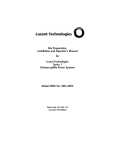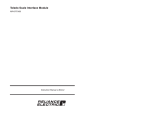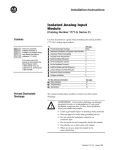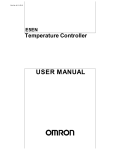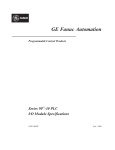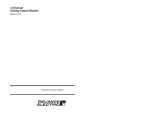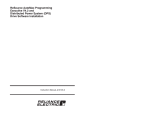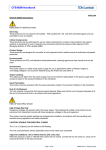Download J-3645-2 RTD Termination Panel
Transcript
! ! ! " ! ! # ! # # ! ! WARNING THIS UNIT AND ITS ASSOCIATED EQUIPMENT MUST BE INSTALLED, ADJUSTED AND MAINTAINED BY QUALIFIED PERSONNEL WHO ARE FAMILIAR WITH THE CONSTRUCTION AND OPERATION OF ALL EQUIPMENT IN THE SYSTEM AND THE POTENTIAL HAZARDS INVOLVED. FAILURE TO OBSERVE THESE PRECAUTIONS COULD RESULT IN BODILY INJURY. WARNING INSERTING OR REMOVING THIS MODULE OR ITS CONNECTING CABLES MAY RESULT IN UNEXPECTED MACHINE MOVEMENT. TURN OFF POWER TO THE MACHINE BEFORE INSERTING OR REMOVING THE UNIT OR ITS CONNECTING CABLES. FAILURE TO OBSERVE THESE PRECAUTIONS COULD RESULT IN BODILY INJURY. ! # ! ! # # ! # Table of Contents 1.0 Introduction . . . . . . . . . . . . . . . . . . . . . . . . . . . . . . . . . . . . . . . . . . . . . . . 1Ć1 2.0 Mechanical/Electrical Description . . . . . . . . . . . . . . . . . . . . . . . . . . . 2Ć1 3.0 Installation . . . . . . . . . . . . . . . . . . . . . . . . . . . . . . . . . . . . . . . . . . . . . . . . 4.0 Diagnostics and Troubleshooting . . . . . . . . . . . . . . . . . . . . . . . . . . . . 4Ć1 3Ć1 Technical Specifications . . . . . . . . . . . . . . . . . . . . . . . . . . . . . . . . . . . . . . AĆ1 Platinum RTD TemperatureĆResistance Values European Curve . . . BĆ1 Field Connections . . . . . . . . . . . . . . . . . . . . . . . . . . . . . . . . . . . . . . . . . . . CĆ1 Related Components . . . . . . . . . . . . . . . . . . . . . . . . . . . . . . . . . . . . . . . . DĆ1 II fafadfdfdasfdsfdsdsdfdsfdsfdsfsdfdsa afdfdsfdsfdfdsfdsfsadfda asfdfaddfdd The 61C615 is an active termination panel that conditions and powers 100 ohm platinum Resistance Temperature Detectors used with the 61C613 analog input module. Four input screw terminals are provided for each 3 wire RTD. A 4th terminal is used to connect the RTD shield to a common ground. This manual describes the functions and specifications of the panel. It also describes how to install, set up, and service the panel. Related publications that may be of interest: D JĆ2605 AUTOMATER 30/40 PRODUCT SUMMARY D JĆ2611 DCS 5000 PRODUCT SUMMARY D JĆ3613Ć1 16 CHANNEL ANALOG INPUT MODULE INSTRUCTION MANUAL D IEEE 518 GUIDE FOR THE INSTALLATION OF ELECTRICAL EQUIPMENT TO MINIMIZE ELECTRICAL NOISE INPUTS TO CONTROLLERS FROM EXTERNAL SOURCES 1Ć1 fafadfdfdasfdsfdsdsdfdsfdsfdsfsdfdsa afdfdsfdsfdfdsfdsfsadfda asfdfaddfdd 2.0 MECHANICAL/ELECTRICAL DESCRIPTION The following is a description of the termination connectors and electrical characteristics of the field connections. 2.1 Mechanical Description The 61C615 is a 19" rackĆmountable termination panel that includes two 6Ćfoot, 50Ćwire twisted pair flat cables and a 6Ćfoot power cable. A separately mounted +15 volt power supply is provided by the user. Refer to figure 2.1. Panel dimensions are listed in Appendix A. When the panel is viewed from the front, the flat cable on the right side of the termination panel (TB2) is for analog inputs 8Ć15. It connects to the bottom connector on the 61C613. The flat cable on the left side of the termination panel (TB1) is for analog inputs 0Ć7. It connects to the middle connector on the 61C613. The top connector on the 61C613 module is not used. The termination panel includes 64 clampĆtype screw terminals for terminating field signals. A clear plastic shield is provided as a cover for the terminal strips. Figure 2.1Ć 61C615 Termination Panel 2.2 Electrical Description The RTD termination panel is used to linearize and power 100 ohm platinum Resistance Temperature Detectors used with the 61C613 analog input module. The resistance change of the RTD with temperature is sensed by using the RTD as the external 4th arm of a bridge. The termination panel contains the internal portions of the bridge as well as the bridge excitation supply. See figure 2.2. 2Ć1 4 SHIELD SENSE (LOW) OUT A OUT B 3 2 1 LOW R LINEARITY PART OF INTERFACE CABLE HIGH R (GND) SHIELD SHIELD 10V REF RANGE Figure 2.2Ć Typical Input Circuit A threeĆwire connection to each RTD allows the effects of lead resistance (up to 5 ohms per lead) to be compensated out. A separate shield connection is also provided. The shield is grounded at the termination panel. The supply for each bridge is modified by the output of a linearizing amplifier to compensate for both bridge and RTD nonlinearities. Three potentiometers are included for each channel to adjust offset, range, and linearity. Nominal full scale is 200 mVolts for a 200 deg. C span, or 100mVolts, depending upon how the panel is calibrated. 2Ć2 3.0 INSTALLATION This section describes how to install and remove the termination panel and its cable assembly. 3.1 Wiring The installation of wiring should conform to all applicable codes. To reduce the possibility of electrical noise interfering with the proper operation of the control system, exercise care when installing the wiring from the system to the external devices. For detailed recommendations refer to IEEE 518. 3.2 Initial Installation WARNING THERE IS NO ISOLATION BETWEEN THE INDIVIDUAL CHANNELS ON THE TERMINATION PANEL. DO NOT CONNECT DIFFERENT CHANNELS ON THE SAME TERMINATION PANEL TO COMMON POINTS OF DIFFERENT POTENTIALS. (FOR EXAMPLE, THIS PANEL SHOULD NOT BE CONNECTED TO RTD DEVICES USED TO MONITOR MOTOR TEMPERATURES BECAUSE THE RTD DEVICES WILL FLUCTUATE IN COMMON MODE VOLTAGE LEVEL BETWEEN THE DIFFERENT MOTORS.) FAILURE TO OBSERVE THIS PRECAUTION MAY DESTROY THE TERMINATION PANEL DUE TO EXCESSIVE CURRENTS FLOWING IN THE COMMON WIRING. Use the following procedure to install the module: Step 1. Turn off power to the system. All power to the rack as well as all power to the wiring leading to the termination panel should be off. Step 2. Mount the termination panel. It should be mounted to permit easy access to the screw terminals on the terminal board. Make certain that the terminal board is close enough to the rack so that the cable will reach between the terminal board and the module. The panel should be located so that the flat cables can be routed to the front of the module without coming in contact with high voltage wires. Step 3. Mount the external power supply. It must be located within a 6Ćft cable run of the termination panel. It should be located so that the power cable can be routed to the termination panel without coming in contact with high voltage wires. Step 4. Connect the power cable on the termination panel to the power supply. Step 5. Fasten field wires to the terminal strip. Make certain that all field wires are securely fastened. The shield should be terminated at the panel. Do not connect the shield at both ends of the cable. Typical field signal connections are shown in figure 3.1. 3Ć1 SENSE (LOW0 3 WIRE 100 OHM RTD LOW R HIGH R (GND) SHIELD 4 3 2 1 Figure 3.1 Ć Typical Field Signal Connections Step 6. Connect the 50Ćpin flat cables to their corresponding connector on the analog input module (61C613). Attach the cables by aligning the triangle marks on the cable end and the board socket. Input channels 0Ć7 (TB1) use the middle connector on the input module. Input channels 8Ć15 (TB2) use the bottom connector. If the rack contains more than one analog input module, make certain that the connectors are the proper ones for this module. Step 7. Turn on power to the system. Step 8. Verify the installation. Refer to the instruction manual for the 16 Channel Analog Input Module (JĆ3613Ć1). The termination panel is adjusted for European curve RTDs (alpha temperature coefficient of 0.00385 ohms/ohm/degree C) and includes an allowance for 0.1 ohm lead resistance. For lead resistance greater than 0.1 ohm, the following procedure can be used to calibrate the input for maximum accuracy: 1. The offset adjustment should not normally need further field adjustment. If it becomes necessary, substitute a precision 100 ohm resistor in place of the RTD and adjust the offset potentiometer for an output of zero volts. The offset potentiometers are located at the back of the panel. Each channel has a separate offset adjustment labeled OS". 2. Adjust the gain potentiometer so that total bridge voltage is 256.3mV across the 100 ohm resistor. The gain potentiometers are located at the back of the panel. Each channel has a separate gain adjustment labeled GN". 3Ć2 3. Force the RTD to a known temperature or simulate a known temperature by connecting a precision resistor at the RTD end of the field wiring. For example, if R = 182.0 ohms, then look up in the table in Appendix B the resistor values above and below 182.0 ohms. With these values and their equivalent temperatures, interpolate to find the expected temperature. Deg. C 210 X 220 OHMS 179.51 182.0ă 183.17 ăăăăX = 216.80 deg. C 4. Adjust the linearity potentiometer for the corresponding simulated temperature. The temperature should be at the upper end of the operating range and must be well away from 0 deg C. The linearity potentiometers are located at the back of the panel. Each channel has a separate linearity adjustment labeled LI". 3.4 Panel Replacement Use the following procedure to replace a termination panel: Step 1. Turn off power to the rack and all connections. Step 2. Use a screwdriver to loosen the screws holding the field wires to the termination panel. Make certain that the wires are tagged so that they can be replaced in the correct order. Step 3. Remove the 50Ćpin flat cables from the back of the termination panel. Step 4. Remove the termination panel. Step 5. Follow steps 2Ć6 in the installation procedure, section 3.2. 3Ć3 fafadfdfdasfdsfdsdsdfdsfdsfdsfsdfdsa afdfdsfdsfdfdsfdsfsadfda asfdfaddfdd 4.0 DIAGNOSTICS AND TROUBLESHOOTING For details on how to troubleshoot the termination panel, refer to the instruction manual for the 16 Channel Analog Input Module (JĆ3613Ć1). 4Ć1 fafadfdfdasfdsfdsdsdfdsfdsfdsfsdfdsa afdfdsfdsfdfdsfdsfsadfda asfdfaddfdd Appendix A Technical Specifications Ambient Conditions D Storage temperature: Ć40_C Ć 85_C D Operating temperature: 0_C Ć 55_C D Humidity: 5Ć90% nonĆcondensing Dimensions D Height: 1.7 inches D Width: 19.0 inches D Depth: 1.6 inches behind rack rails 2.5 inches in front of rack rails Input Circuit D Number of inputs: 16 D Type: 100 ohm (@ 0 degrees C) platinum RTD D Resistance curve: European. Alpha = 0.00385 ohms/ohm/deg. C D Isolation: All channels on panel have a common ground. Entire panel may operate at nonĆzero common mode voltage depending on input board common mode range and power supply isolation. D Connections: ScrewĆactivated, clamp type barrier strips. Accomodates 24 to 14 AWG wire. Four connections/RTD. Output Circuit D Linearized range: -20 to +250 deg. C D Sensitivity: .5mVolt/deg. C D Zero point: 0 deg. C D Linearization error for 0.1 ohm lead resistance: <0.1 deg. C (Ć20 to 250 deg.C) for 0.1 to 0.2 ohm resistance: <0.1% reading + 0.1 deg. C (-20 to 250 deg. C) or <.25 deg. C (-20 to 200 deg. C) D Temperature variation (0Ć55 deg. C): 0.5% of reading, 0.2mVolts max D Connections: 50 wire twisted pair flat cable per 8 channels, 6 ft long. One end hardwired into panel; other end terminated in a connector (3M part no. 3425Ć6050). AĆ1 Appendix A (Continued) Power Requirements +15 Volts: 100 mA -15 Volts: 160 mA Voltage tolerance: +1% Voltage temp Coef.: 0.02%/deg.C Line regulation: 0.1% Load regulation: 0.1% Ripple: <2 mVolts RMS Protection: Each line fused at 1A and reverse voltage protected. Fuse type: Littelfuse 276001 Connector: 3 wire cable, 6 ft. long with spad lugs +15 Volts Ć yellow -15 Volts Ć violet ground Ć gray WARNING UNUSED INPUTS SHOULD BE CLOSED. OPEN INPUTS CAN CAUSE Ć15V CURRENT TO INCREASE BY 15MA PER CHANNEL AND +15V CURRENT TO INCREASE BY 10MA PER CHANNEL. JUMPER SENSE" TO HIGH R" (GROUND) AT ALL UNUSED INPUTS. FAILURE TO OBSERVE THIS PRECAUTION COULD RESULT IN BODILY INJURY OR DAMAGE TO EQUIPMENT. AĆ2 Appendix B Platinum RTD TemperatureĆResistance Values European Curve Alpha = 0.00385 ohms/ohm/deg.C Deg.C ohms Deg.C ohms -150 39.65 180 168.47 -140 43.80 190 172.16 -130 47.93 200 175.84 -120 52.04 210 179.51 -110 56.13 220 183.17 -100 60.20 230 186.82 -90 64.25 240 190.46 -80 68.28 250 194.08 -70 72.29 260 197.70 -60 76.28 270 201.30 -50 80.25 280 204.88 -40 84.21 290 208.46 -30 88.17 300 212.03 -20 92.13 310 215.58 -10 96.07 320 219.13 0 100.00 330 222.66 10 103.90 340 226.18 20 107.79 350 229.69 30 111.67 360 233.19 40 115.54 370 236.67 50 119.40 380 240.15 60 123.24 390 243.61 70 127.07 400 247.06 80 130.89 410 250.50 90 134.70 420 253.93 100 138.50 430 257.34 110 142.28 440 260.75 120 146.06 450 264.14 130 149.82 460 267.52 140 153.57 470 270.89 150 157.32 480 274.25 160 161.05 490 277.60 170 164.76 500 280.93 BĆ1 fafadfdfdasfdsfdsdsdfdsfdsfdsfsdfdsa afdfdsfdsfdfdsfdsfsadfda asfdfaddfdd Appendix C Field Connections TB1 TB2 1 Pin 32 Channel 1 Input Pin 32 Channel Input 1 2 3 4 0 0 0 0 Shield High R Low R Sense 1 2 3 4 8 8 8 8 Shield High R Low R Sense 5 6 7 8 1 1 1 1 Shield High R Low R Sense 5 6 7 8 9 9 9 9 Shield High R Low R Sense 9 10 11 12 2 2 2 2 Shield High R Low R Sense 9 10 11 12 10 10 10 10 Shield High R Low R Sense 13 14 15 16 3 3 3 3 Shield High R Low R Sense 13 14 15 16 11 11 11 11 Shield High R Low R Sense 17 18 19 20 4 4 4 4 Shield High R Low R Sense 17 18 19 20 12 12 12 12 Shield High R Low R Sense 21 22 23 24 5 5 5 5 Shield High R Low R Sense 21 22 23 24 13 13 13 13 Shield High R Low R Sense 25 26 27 28 6 6 6 6 Shield High R Low R Sense 25 26 27 28 14 14 14 14 Shield High R Low R Sense 29 30 31 32 7 7 7 7 Shield High R Low R Sense 29 30 31 32 15 15 15 15 Shield High R Low R Sense n.c. n.c. n.c. n.c. 33 34 35 36 33 34 35 36 n.c. n.c. n.c. n.c. R = resistance n.c. = no connection CĆ1 fafadfdfdasfdsfdsdsdfdsfdsfdsfsdfdsa afdfdsfdsfdfdsfdsfsadfda asfdfaddfdd fafadfdfdasfdsfdsdsdfdsfdsfdsfsdfdsa afdfdsfdsfdfdsfdsfsadfda asfdfaddfdd fafadfdfdasfdsfdsdsdfdsfdsfdsfsdfdsa afdfdsfdsfdfdsfdsfsadfda asfdfaddfdd For additional information 1 Allen-Bradley Drive Mayfield Heights, Ohio 44124 USA Tel: (800) 241-2886 or (440) 646-3599 http://www.reliance.com/automax Publication J-3645-2 - January 1991 Copyright © 2002 Rockwell Automation, Inc.. All rights reserved. Printed in U.S.A.


























